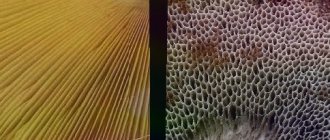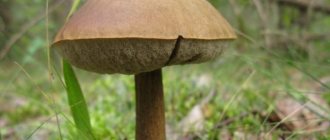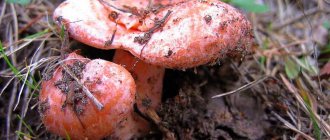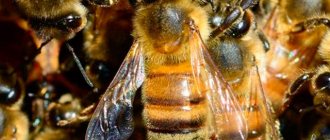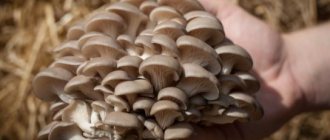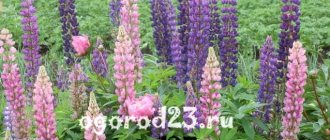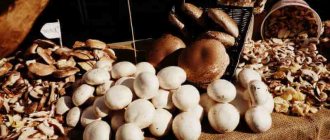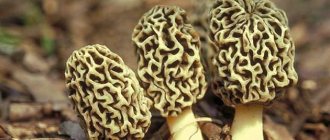» Mushrooms » Lamellar mushrooms: varieties and their description
0
3511
Article rating
Lamellar mushrooms are considered the most popular. There are many edible and poisonous varieties found in nature. To learn to recognize them, you need to familiarize yourself with the external description and name of each species.
- Inedible
- Death cap
- fly agaric
- Fiber fiber
- False honey fungus
- Galerina bordered
- Entoloma spring
- Leopard print row
- Beneficial features
- Contraindications
- Cooking features
- Interesting Facts
Lamellar mushrooms: varieties and their descriptions
Characteristic features of the species
A characteristic difference between lamellar type mushrooms and spongy ones is the spore-containing hymenophore, consisting of radial plates diverging from the stalk to the edges. The shape of the cap varies, it may look like an inverted cone, changing during growth, it can be cushion-shaped, prostrate, bell-shaped, with a tubercle or depression - it depends on the species. The fruiting body has a fragile structure, unlike its spongy counterparts.
The stalk consists of a large number of hyphae - thin fibers, similar to threads, which are very tightly united. Basically, they are cylindrical, hollow inside; combinations of hollow and solid parts are less common.
Often, in the early stages of growth, the stem is connected to the cap by a thin film, usually white. During growth, the film breaks, forming a kind of ring on the stem, which serves as a distinctive feature for both edible (for example, honey mushrooms, annular cap) and poisonous mushrooms (fly agaric, toadstool).
A distinctive feature of some lamellar ones is the presence of juice, which is released when cut. This liquid is milky or clear in color, has a thick and watery consistency, and has a bitter aftertaste, which can be removed by soaking and boiling.
Often such mushrooms (milk mushrooms, milk mushrooms, bitter mushrooms) are used for pickling. Varieties that lack juice are called crackers; in the sun they do not rot, but dry out.
Types of edible agaric mushrooms
This subspecies combines thousands of varieties. There are many similar, false, and poisonous ones, so in order to always choose edible mushrooms, you need to study photos, characteristics and features of representatives of the species.
The most famous species of this group can be considered:
- Milk mushroom, which is common in the northern regions of Russia, the Urals and the Volga region. Loves moist, shaded places and grows close to the ground. The mushroom has a wide white cap, which is connected to a very thick stalk. The flesh of the fruiting body is elastic, but very brittle; milky juice is released at the break, which turns yellow in the open air. It has a pleasant specific aroma.
- The common champignon has a forest counterpart, which grows throughout Europe in forests, semi-deserts, and in the Russian Federation it is found in temperate zones. Fruits from June to October. This is a mushroom with a brown spherical cap and a long thin stalk of white or gray color. The pulp is dense, white, darkens when exposed to high temperatures. It has a pleasant powdery smell.
- Russulas are common in Europe, Asia, Russia, America, and are found even in Africa. Often found in deciduous and coniferous forests and swamp areas. They grow from June to October. The color of the hemispherical cap is brown, reddish, brown, it is attached to a thick white stem. The pulp is white in color and the structure is very soft and crunchy. Russulas have a pleasant forest smell and delicate taste.
Gray rows with a thick leg
Ryadovka is a large group of agaric mushrooms united into a separate genus. Rowers tend to grow in large groups, arranged in rows or rings.
Earthy
Conditionally edible mushroom. It is found under the names of little mice and earthy-gray row.
Young fruits have caps that are conical or bell-shaped, with a pronounced tubercle and rolled up edges. As they grow older, the shape of the caps becomes prostrate. The surface of the caps is fibrous-scaly. It can be colored ashen, mousey or dark shades of gray.
The stem of the earthy variety is white, covered with a powdery coating on top. Often on its surface you can see the remains of a private bedspread. The white plates under the mushroom cap turn gray with age. They may also develop yellow spots.
The flesh of mice is thin and brittle. The whitish interior of the mushroom does not change color when cut. The pulp emits a floury smell. The taste is soft and pleasant.
Gray
An edible lamellar representative of the Rowadovaceae family. Synonymous names - gray sandpiper, gray sandpiper, pine grass, hatched row, green grass.
The wide bell-shaped caps of the gray row transform into convex-prostrate ones as the fungus develops. Then they acquire a flat-spread shape. In old fruits, the edges of the cap become wavy and covered with cracks. A characteristic tubercle is always preserved in the center of the cap. The surface is dry. On a light gray background, dark radial strokes radiate from the center of the cap.
The leg of the serushka is cylindrical and light-colored. With age, the white plates become grayish and covered with yellow spots. In old mushrooms, the plates may be completely lemon-yellow.
The flesh is white in the cap part and yellowish in the stem area. It gives off a light floury aroma. The taste is soft, slightly sweet.
Soapy
Despite the unappetizing name, this type of mushroom belongs to the conditionally edible category. Its fruits can be eaten after certain processing. Soap row is called for the unpleasant odor emanating from the pulp. For many, this amber evokes associations with laundry soap.
Outwardly, this variety is very similar to the gray row, however, it differs in the darker color of the plates, the olive tint of the color of the caps, the flesh that turns red at the break, and the smell that has nothing to do with the flour aroma.
Separate
In the isolated row, the shape of the cap also changes depending on the stage of fruit development. Young mushrooms have bell-shaped caps, while adults have flattened caps with the edges turned inward. The surface color is olive-brown with a gray tint. The edges of the cap are always a little lighter.
The initially white stem of the row changes its color to greenish or olive as it ages. Below it is always dark gray or black. The surface of the leg is covered with small scales. The plates are white, sometimes grayish. The pulp is whitish, with a bitter taste and smell. The mushroom belongs to the conditionally edible group.
Smoky
The cap of young fruits is hemispherical or cushion-shaped. Later it transforms into a half-prostrate position with jagged edges. The surface is smooth, painted with a brownish shade of gray.
The leg is cylindrical, slightly thickened at the base. Often it is intertwined or fused with the legs of other fruits within the mycelium. It is painted whitish on top and brown on the bottom. The white plates are located freely or weakly fused with the stalk.
The pulp of the conditionally edible smoky row is white, dense, thick. It is characterized by a floury “row” smell.
Pointed
An inedible and toxic representative of the Rowadovaceae family. A counterpart to the earthy variety. The mushroom is also known as mouse, striped and hot-spicy row.
As the fruits develop, their caps change shape from bell-conical to hump-shaped. The color is ash gray. The central zone of the cap surface is always darker, the edges are striped.
The leg is cylindrical, thickened at the bottom. The main tone of the surface is whitish, with a pattern of darker longitudinal stripes. Young rows have white or gray plates. Over time, they change their color to ashen. The pulp is white and smells like freshly ground flour.
Tiger
Another representative of poisonous rows. Other names of the species are leopard row, poisonous row.
Relatively small mushrooms with spherical, then bell-shaped, convex, then flat-spread caps with the edges tucked inward. Often there are cracks and distortions on the surface of the cap. The color of the cap is varied - from a whitish or silvery shade of gray to a dark and bluish-gray color. The entire surface is covered with dark flake-like scales, which create a tiger pattern.
The leg is white or ocher-white. But its base is always painted a rusty shade of brown. The whitish plates are connected to each other by platelets. Mature mushrooms produce droplets of liquid on them. The pulp is dense, whitish. The color does not change when cut. It also has a powdery smell.
Conditionally edible fruits
The main difference between semi-edible mushrooms and regular ones is that they cannot be eaten raw. In order for these varieties to become edible, they must be subjected to additional processing: some types must be boiled repeatedly, draining the broth, while others need soaking and frying.
It is very difficult to distinguish conditionally edible mushrooms from others by external signs, since they do not stand out in anything remarkable.
Note!
If you are not sure that the mushroom is edible, then under no circumstances should you try it raw, only after heat treatment.
These types do not contain hallucinogenic or toxic substances, but some types have a specific taste that disappears during their preparation.
These fruits have representatives that contain either milky juice, for example, milk mushrooms, milk mushrooms, or mildly toxic substances - contained in the lines. In the first case, you can get rid of this by soaking the mushroom for a while, in the second - by drying and repeatedly boiling it.
The most famous of the variety:
- milk mushrooms white and black;
- milky white and brown;
- purple row;
- poplar row;
- winter honey fungus.
How to distinguish from poisonous varieties?
The main characteristic of a poisonous mushroom is the structure of the hymenophore. It is also worth paying attention to the color and shape of the fruit; the smell and taste are not necessarily unpleasant, which can be misleading. Ordinary varieties can also be dangerous to life and health if they are overripe or grow in environmentally polluted areas, for example, near industrial zones or highways. There are about 30 inedible varieties among the lamellar ones.
| Name | hat | Leg | Fruiting body |
| Death cap | Color – grayish, with a green tint. Shape – round or prostrate. | The shape is cylindrical. It has a characteristic thickening at the base. | White color. The structure is fleshy. Has a weak mushroom taste and aroma. |
| Panther fly agaric | Color – brown or grayish-orange. It has a large number of white speckled growths. | The shape is cylindrical. The structure is dense. It has a thickening at the bottom and a characteristic frill. | White color. The smell is pungent and unpleasant. |
| False honey agaric | Color – gray-yellow, with a red tint in the center. The shape is convex. | The shape is cylindrical. Hollow inside. It has a reddish color at the base. | Color – gray-yellow. The smell is very unpleasant. Has a bitter taste. |
Distribution by region
Each region has its own popular mushrooms, which are most often found in the forest and end up on the table of mushroom pickers.
Lamellar mushrooms of the Moscow region
The nature of the Moscow region is rich in a large number of mushroom places, which is due to the presence of deciduous tracts, in which the most common are:
- honey mushrooms;
- chanterelles;
- saffron milk caps;
- Russula;
- milk mushrooms;
- Champignon;
- purple and gray rows.
The peak of the harvest occurs in August-September. There are dozens of places in the region where you can organize a “quiet hunt”; popular ones include Ruzsky, Yegoryevsky, Odintsovo, Kolomensky, Meshchersky and Dmitrovsky districts.
Mushrooms of the Leningrad region
The Leningrad region is famous for its coniferous forests, in which you can find:
- chanterelles;
- red and yellow russula;
- bitters;
- black milk mushrooms.
The collection season begins at the end of April, the peak month is August, during which toadstools and fly agarics also actively grow. The villages of Sosnovo and Snegirevka are considered popular fertile places.
Views of Belarus
The climate of Belarus, as well as extensive coniferous, mixed and deciduous groves, are ideal for the emergence of a large number of mushroom places. The following grow on the territory:
- umbrella mushroom;
- milk mushrooms;
- Russula;
- chanterelles;
- saffron milk caps.
The collection period lasts from April until the first frost, and in warm and humid September, autumn mushrooms, such as honey mushrooms, which are popular among mushroom pickers, begin to actively grow. The most productive places are located near Minsk and Vitebsk, their names are the Khatyn forest, Logoischina, the village of Stolbtsy.
Collection rules
The basic rule of “quiet” hunting is not to take a mushroom that is in doubt. But inexperienced mushroom pickers often neglect it, which is why there are so many poisonings during the season. To avoid unpleasant consequences, you need to learn to distinguish between edible and poisonous agaric mushrooms. There are several rules for collecting them that it is advisable to remember for those who love “quiet” hunting.
- You need to pick mushrooms only in forests and meadows away from the city, industrial enterprises and roads. Toxic substances accumulate in them, so you can even get poisoned by an edible mushroom.
- You should not take very large, overripe, wormy or damaged fruits.
- You need to cut the fruit with the stem, this makes it easier to recognize the characteristic signs of edible and poisonous species.
- It is better to put it in a basket; in a bag the fruits quickly break and spoil. Before putting it down, examine it carefully and clear it of any debris.
- For the lamellar family, the method of recognizing poisonous species by smell is not suitable. Some varieties may smell nice but will be inedible.
- The collected fruits should be prepared on the same day; it is better not to store them.
You must also remember that mushrooms are a healthy food, but difficult to digest. They are not recommended for use by children under 6 years of age, as well as by people with diseases of the gastrointestinal tract.
Lamellar mushrooms are the most common and popular group. Among them there are both valuable and tasty fruits and deadly poisonous ones. You need to learn to distinguish between them, this will help you enjoy delicious mushroom dishes and avoid poisoning.
Useful properties and restrictions on use
There is no definite answer whether mushrooms are useful or not, since they contain a lot of microelements that can affect the body in different ways. They contain large quantities of pure protein, but are low in calories. The product contains vitamins such as B1, B2, C, PP, D, A, magnesium, potassium, phosphorus and amino acids, which stimulate brain function and contribute to the body's resistance to stress.
Poisonous lamellar mushrooms
The downside is that due to their spongy structure and rapid growth, mushrooms can absorb toxins and radionuclides, so you should carefully choose the collection site. In addition to useful microelements, the fruits contain chitin, which is difficult to digest.
It is not recommended for consumption by people who have stomach problems, as it may cause exacerbation of diseases. For those who suffer from pancreatitis and peptic ulcers, this product is strictly prohibited. Any variety should be consumed in limited quantities so as not to harm the body.
Places and timing of growth
Lamellar mushrooms can be found in different areas - forests, steppes, forest-steppes, park areas, gardens, fields.
They prefer to grow in sandy or sandy loam soil with high humidity and an admixture of deciduous compost, on dead wood. They are characterized by the ability to form mycorrhiza (especially with tree species).
Some species are considered parasites - as they grow, they destroy the trunks of living trees.
Fruiting is long: begins in early March and ends in late autumn. Many specimens are successfully cultivated not only industrially, but also privately.
Recipes and features for preparing agaric mushrooms
Despite the fact that these are mushrooms of the same group, different types require different approaches when cooking:
- milk mushrooms contain milky juice, so they are soaked for at least 3 days before salting;
- Oyster mushrooms and champignons are universal, suitable for any dish and combined with different ingredients;
- Russulas are boiled, stewed, pickled, fried. They are not suitable for drying, as their structure is too fragile. It is necessary to remove the skin from the cap before cooking;
Boiled russula - Autumn honey fungus is very tasty when fried; in addition, it can be salted and pickled.
There are many ways to prepare these mushrooms, the basic ones being frying and stewing:
- Fried chanterelles: heat 100 ml of sunflower oil in a frying pan;
- add 300 grams of pre-boiled and squeezed chanterelles;
- increase heat, brown, stirring;
- Reducing the heat, pour in 300 ml of a mixture of sour cream and water;
- add chopped onion, salt;
- Bring to readiness under the lid.
Fried chanterelles
- place 0.5 kg of boiled and thoroughly squeezed fruits on a greased baking sheet;
Baked champignons
Often, spices are not needed, but if desired, you can add garlic, onion, allspice, basil, oregano, and marjoram.
With a black hat
And such mushrooms are found in our forests. Perhaps not every mushroom hunting fan noticed them on their way or were simply afraid to take them. On the one hand, this is correct, since you only need to collect those mushrooms that you know well. On the other hand, it’s worth asking which mushrooms have a resinous cap, because many of them are tasty and healthy.
Coprinus gray
Despite the fact that the name contains the adjective “gray”, in fact, many adult specimens are characterized by significant signs of a tar color. Most often, mushrooms can be found in central Russia.
They grow in sparse bunches, preferring rotten stumps and forest roads.
You can also find gray coprinus in places where animals graze, on dung heaps. This fact often scares off mushroom pickers, who call the mushroom “dung beetle . The shape of the cap is bell-shaped, with a diameter of no more than 10 cm. The top cover is smooth, the edges are uneven. In adult mushrooms, the caps split into individual fibers. The leg is thin, 1–2 cm in diameter.
Did you know? The world's creepiest mushroom
-
Anthurus Archer.
Outwardly, it resembles a starfish or octopus, bright red in color, and has a disgusting smell. Popularly called "
Devil's Fingers
"
.
Gray chanterelle
This is one of the representatives of Chanterelles, which is often ignored by mushroom pickers due to its external features . The mushroom is a fruiting body, where the stem and cap are a single whole, i.e. there is no pronounced border. The hat can have a diameter from 2 to 15 cm, is deep in the center, and the edges are curved and wavy.
The gray-black, and sometimes rich resin cap, open at the top, gradually narrows and turns into a stem. The latter has a light ash color, curved, hollow inside. The mushroom pulp is tender and elastic, with a pleasant tart taste.
Gray chanterelles grow mainly in deciduous and mixed forests. They can be collected from July to early October. Mushrooms are suitable for cooking in any form.
When going to the forest to pick mushrooms, try to find out as much information as possible about what species grow in your area, what they look like, and which of them are edible. If you have the slightest doubt, it is better to refuse the mushroom, even if it looks amazingly attractive.

